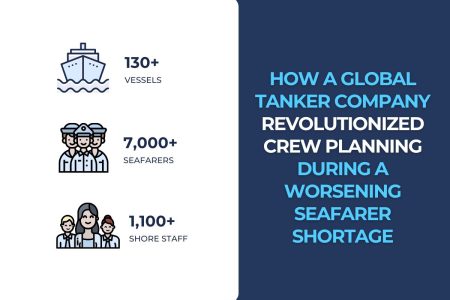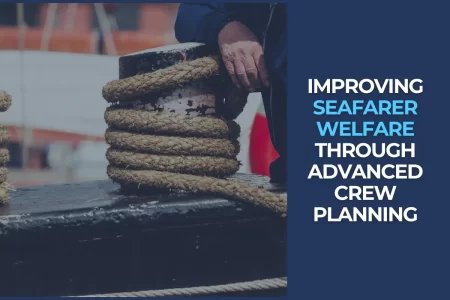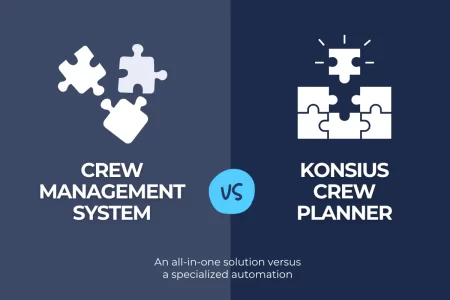The maritime industry, a crucial backbone of global trade, is currently grappling with a severe and worsening shortage of qualified seafarers. A recent report from BIMCO and the International Chamber of Shipping (ICS) highlights the gravity of this situation, warning that unless immediate measures are taken, the deficit of skilled seafarers could seriously impact the efficiency and safety of maritime operations.
However, one area where companies can make a meaningful difference is in the strategic optimization of crew planning. By more efficiently utilizing existing pool of seafarers, shipping companies can mitigate some of the adverse effects of this global workforce shortage.

Insights from the BIMCO and ICS Report
The BIMCO-ICS Seafarer Workforce Report underscores a challenging reality: global demand for seafarers is rapidly outpacing supply. With a projected shortage of 26,240 officers in the near future, the report calls for urgent action from industry stakeholders. Contributing factors include an aging workforce, high attrition rates, and challenges related to crew welfare, especially after the disruptions caused by the COVID-19 pandemic.
How Better Crew Planning Can Help
To address these challenges, optimizing crew planning is emerging as a critical strategy. Rather than simply hiring more seafarers—an increasingly difficult feat in the current environment—shipping companies must maximize the efficiency and effectiveness of their existing workforce. Here’s how enhanced crew planning can make a difference:
1. Optimizing Crew Rotations
The report emphasizes that one key to tackling seafarer shortages lies in smart rotation planning. Companies that use data-driven scheduling tools can better align crew availability with operational needs. This ensures that seafarers are deployed efficiently, minimizing downtime and avoiding scenarios where ships are understaffed.
2. Prioritizing Crew Well-being
Fatigue and burnout are persistent issues in the maritime industry, and poor crew management can exacerbate these problems. Effective crew planning accounts for proper rest periods and work-life balance, which can significantly improve crew retention. Healthier, well-rested seafarers are also more productive and less likely to make costly errors.
3. Maximizing Crew Skillsets
The BIMCO and ICS report stresses the importance of not just filling roles but matching the right skills to the right tasks. An automated crew planning solution can be utilized to track certifications, training needs, and competencies, enabling companies to deploy seafarers in a way that maximizes their abilities while adhering to international standards.
4. Improving Predictability and Stability
Uncertainty in scheduling has long been a source of frustration for seafarers. By adapting an advanced crew planning solution, shipping companies can make more precise scheduling decisions based on historical data and key performance indicators. This method allows for more stable and efficient crew planning, boosting crew morale and reducing turnover.
Leveraging Advanced Crew Planning Solutions
Instead of relying on basic scheduling practices, advanced crew planning solutions like Konsius Crew Planner use decision science algorithms to optimize outcomes under real-world constraints. These solutions analyze various factors such as crew availability, skillsets, regulatory compliance, and operational demands to produce optimal crew schedules.
For instance, our system can process information on the length of sea service, mandatory rest periods, and certifications due for renewal, recommending ideal crew rotation plans. By offering structured, data-driven strategies, these solutions ensure the efficient allocation of resources without speculative forecasting.
Building a Resilient Workforce
The BIMCO-ICS report also emphasizes the need to invest in the future maritime workforce. While better crew planning addresses immediate challenges, companies must also think long-term. This involves supporting training initiatives, developing career pathways for younger seafarers, and creating an industry culture that values continuous learning and professional development. Proactive engagement with maritime academies and offering mentorship programs can build a sustainable talent pipeline, reducing the reliance on reactive hiring.
Optimize current workforce allocation
The seafarer shortage is a multifaceted issue that requires a strategic approach. By adapting advanced crew planning solutions to optimize current resources, shipping companies can mitigate some of the most pressing challenges identified in the BIMCO-ICS report. Not only does this enhance operational efficiency and safety, but it also contributes to a more sustainable and attractive maritime industry for future generations.



